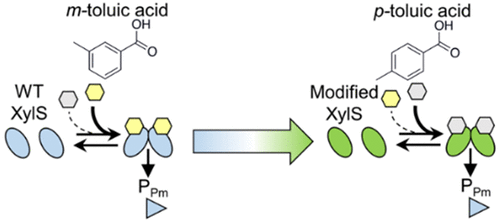当前位置:
X-MOL 学术
›
ACS Synth. Biol.
›
论文详情
Our official English website, www.x-mol.net, welcomes your feedback! (Note: you will need to create a separate account there.)
Switching the Ligand Specificity of the Biosensor XylS from meta to para-Toluic Acid through Directed Evolution Exploiting a Dual Selection System.
ACS Synthetic Biology ( IF 4.7 ) Pub Date : 2019-11-21 , DOI: 10.1021/acssynbio.9b00237 Yuki Ogawa 1 , Yohei Katsuyama 1, 2 , Kento Ueno 1 , Yasuo Ohnishi 1, 2
ACS Synthetic Biology ( IF 4.7 ) Pub Date : 2019-11-21 , DOI: 10.1021/acssynbio.9b00237 Yuki Ogawa 1 , Yohei Katsuyama 1, 2 , Kento Ueno 1 , Yasuo Ohnishi 1, 2
Affiliation

|
The Pseudomonas putida transcriptional activator XylS induces transcription from the Pm promoter in the presence of several benzoic acid effectors, with m-toluic acid being the most effective and p-toluic acid being much less effective. To alter the effector specificity of XylS, we developed a dual selection system in Escherichia coli, which consists of (i) an artificial operon of an ampicillin resistance gene and tetR under Pm promoter control and (ii) a chloramphenicol resistance gene under tetR promoter control. This system enabled both positive selection to concentrate XylS mutants recognizing a desired ligand and negative selection to exclude undesired XylS mutants such as those recognizing undesired ligands and those that are active without effectors. Application of a random mutagenesis library of xylS to directed evolution that exploited this selection system yielded two XylS mutants that recognize p-toluic acid more effectively. Analysis of each missense mutation indicated three amino acid residues (N7, T74, and I205) important for p-toluic acid recognition. Then, a codon-randomized xylS library at these three residues was similarly screened, resulting in three XylS mutants with increased p-toluic acid-recognition specificity. Analysis of each amino acid substitution revealed that T74P attributes to both m-toluic acid sensitivity loss and subtle p-toluic acid sensitivity acquisition, and that N7R increases the overall ligand-sensitivity. Finally, the combination of these two mutations generated a desirable XylS mutant, which has a high p-toluic acid sensitivity and scarcely responds to m-toluic acid. These results demonstrate the effectiveness of the dual selection system in the directed evolution of biosensors.
中文翻译:

通过定向进化开发双重选择系统,将生物传感器XylS的配体特异性从间位酸转换为对甲苯甲酸。
在几种苯甲酸效应物的存在下,恶臭假单胞菌转录激活因子XylS诱导了Pm启动子的转录,其中间甲苯甲酸是最有效的,对甲苯甲酸的效力要差得多。为了改变XylS的效应子特异性,我们在大肠杆菌中开发了双重选择系统,该系统由(i)氨苄青霉素抗性基因和tetR的人工操纵子在Pm启动子控制下和(ii)在tetR启动子控制下的氯霉素抗性基因组成。该系统既可以进行正选择以浓缩识别所需配体的XylS突变体,又可以进行负选择以排除不期望的XylS突变体,例如那些识别不期望的配体的突变体以及那些没有效应子的活性的突变体。利用该选择系统将xylS随机诱变文库应用于定向进化,产生了两个XylS突变体,它们可以更有效地识别对甲苯甲酸。每个错义突变的分析表明,三个氨基酸残基(N7,T74和I205)对对甲苯甲酸的识别很重要。然后,类似地筛选在这三个残基处的密码子随机化的xylS文库,得到三个对甲苯甲酸识别特异性增强的XylS突变体。对每个氨基酸取代的分析显示,T74P归因于间甲苯甲酸敏感性损失和微妙的对甲苯甲酸敏感性获取,而N7R增加了总体配体敏感性。最后,这两个突变的组合产生了理想的XylS突变体,对甲苯甲酸敏感性高,几乎不响应间甲苯甲酸。这些结果证明了双重选择系统在生物传感器的定向进化中的有效性。
更新日期:2019-11-21
中文翻译:

通过定向进化开发双重选择系统,将生物传感器XylS的配体特异性从间位酸转换为对甲苯甲酸。
在几种苯甲酸效应物的存在下,恶臭假单胞菌转录激活因子XylS诱导了Pm启动子的转录,其中间甲苯甲酸是最有效的,对甲苯甲酸的效力要差得多。为了改变XylS的效应子特异性,我们在大肠杆菌中开发了双重选择系统,该系统由(i)氨苄青霉素抗性基因和tetR的人工操纵子在Pm启动子控制下和(ii)在tetR启动子控制下的氯霉素抗性基因组成。该系统既可以进行正选择以浓缩识别所需配体的XylS突变体,又可以进行负选择以排除不期望的XylS突变体,例如那些识别不期望的配体的突变体以及那些没有效应子的活性的突变体。利用该选择系统将xylS随机诱变文库应用于定向进化,产生了两个XylS突变体,它们可以更有效地识别对甲苯甲酸。每个错义突变的分析表明,三个氨基酸残基(N7,T74和I205)对对甲苯甲酸的识别很重要。然后,类似地筛选在这三个残基处的密码子随机化的xylS文库,得到三个对甲苯甲酸识别特异性增强的XylS突变体。对每个氨基酸取代的分析显示,T74P归因于间甲苯甲酸敏感性损失和微妙的对甲苯甲酸敏感性获取,而N7R增加了总体配体敏感性。最后,这两个突变的组合产生了理想的XylS突变体,对甲苯甲酸敏感性高,几乎不响应间甲苯甲酸。这些结果证明了双重选择系统在生物传感器的定向进化中的有效性。



























 京公网安备 11010802027423号
京公网安备 11010802027423号